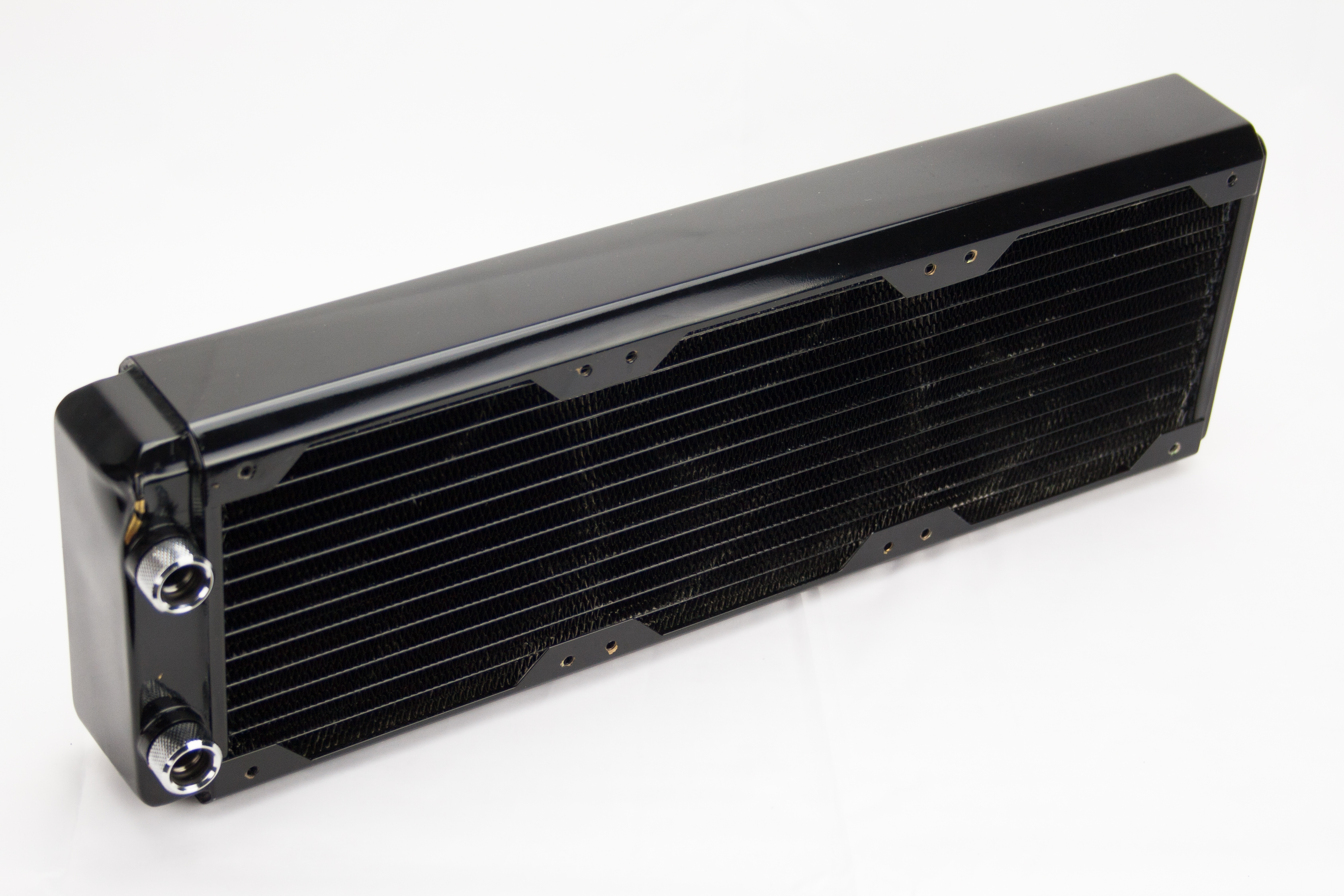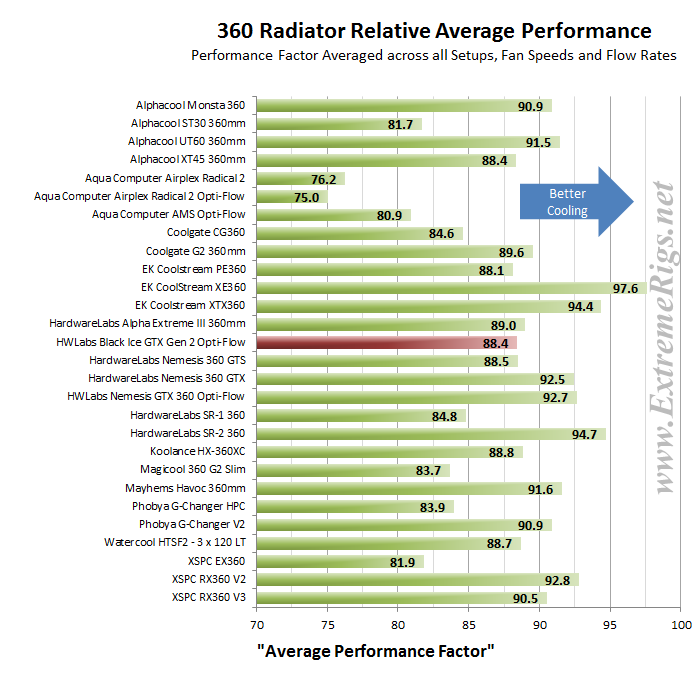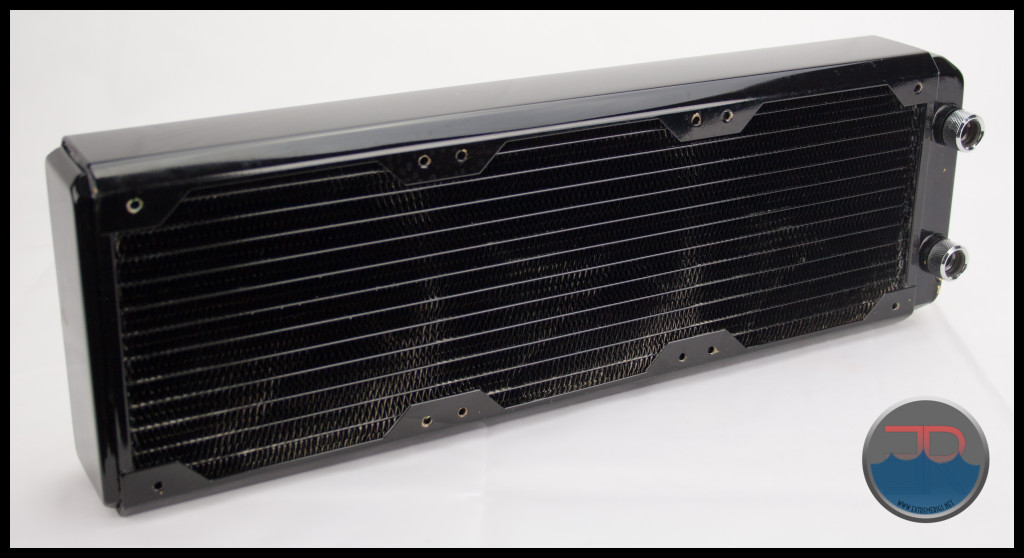Thermal Performance
Thermal Performance scores are derived from the relevant Performance Factor scores. We set this scale with 75% and below as the 0 mark, with each 2.5% increase from 75% in relative performance adding 0.5 to the awarded performance score.
Push Only Thermal Performance – 1.5/5
The GTX’s Push Only APF result of 80.3 placed it in 3rd last. It placed 5th in the 1850 rpm test but the medium and low fan speed results which were very weak drastically impacted it’s Push Only ranking and APF score.
Push/Pull Thermal Performance – 4.5/5
As we have seen in the data analysis the GTX performed very well in medium and high speed Push/Pull tests, while not so good at the low fan speed. The excellent 1300 rpm (3 x 2nd places) and 1850 rpm (3 x 1st places) kept the averages high and the GTX finished in 2nd place for Push/Pull. The GTX’s P/P APF score of 96.5 resulted in a P/P performance score of 4.5/5.
Overall Thermal Performance – 3/5
The Master Performance score of 88.4 gives a score of 3.0/5 and places the GTX in equal 16th for the overall APF ranking. The more air flow through the GTX, the better it performed, It’s 3.0 score seems appropriate given it was so strong with lots of air flow but so weak with low air flow. If nothing else it shows that our auto scoring system is working well when looking at the entire picture.
Features & Quality – 3.5/5
The GTX 360mm has HWLabs renowned build quality built into its DNA. It feels solid and weighty, is well constructed and the glossy black finish is excellent.
The GTX is perhaps HWLabs oldest model still available and it kind of shows in the features (or lack of) that it has. Just single port options, no fill/bleeder port, and no screw guards. Maybe an updated revision of the GTX is in order with features which end users now come to expect.
The core of the GTX is heavily biased towards high speed fans, due to it’s dense core which has 20 FPI. Due to this dense core dedicated cleaning will be require more often that rads with a lower FPI count. Such is the price you pay for maximum thermal performance.
The GTX’s high restriction level mean you should consider the required pump power when planning out your loop, particularly if want to run more than one of them in your loop.
Summary – 3.5/5
The Hardware Labs Black Ice GTX is an excellent thermal performer with high fan speeds – particularly when run with a Push/Pull fan assembly. This is what it is designed for. Low pressure/speed fans just won’t get the performance out of the Black Ice GTX radiator. If you want extreme performance and can deal with the associated fan noise and regular cleaning then the GTX is for you, there is nothing better!
If you desire a quite rig with low fan speeds, then it’s best to look elsewhere, as this is not the GTX’s strong point.
The design, build quality and finish are excellent. The GTX does have it’s drawbacks though with a lack of features such as any extra ports.
I’ve had 2 x 560mm GTX rads in my personal test bench for years, and the results of the 360mm GTX thermal tests were very satisfying. A test bench scenario where we’re attempting to wring every ounce performance out of our hardware is probably where the GTX is best suited. In a normal case enclosure, excellent airflow is essential to get the best from the GTX.
The GTX is not for every one or every build, but for the niche corner of the market the GTX is still at the very top of the thermal performance pack!














[…] Hardware Labs Black Ice® GTX 360mm Radiator Review […]
Thanks for the review again.
I think that the issue of screw protectors again, seems to be a design flaw. This is a bigger problem with the GTX 360 than other radiators simply because it is a radiator designed for high rpm fans. By nature, you are far more likely to use 38mm fans with such a radiator in push pull for the added static pressure.
Otherwise, it’s a solid radiator.
I would love to see a “Monster” radiator with 20 fpi and a similar design, but I suspect it would be a niche product.
Keep in mind that the GTX is an older model and that what we now consider important features were not always incorporated a few years ago. The current generation of HWLabs offerings all feature protection plates.
If I am not mistaken though the Black Ice GTX Gen 2 though (the variant for high rpm fans in push pull) still does not have screw protectors.
The HW Labs site is currently down so I cannot look it up.
Hi, which fans can use with this radiator?
Any 120mm fans would work – but if you’re buying this rad we would assume it’s to make use of it’s higher performance with highspeed fans. So something in the 2000+RPM is probably the target.
this rad i already have it, can you suggest me 6 fan with low noise?
Thanks in advance
There is a definite intangible when it comes to fan noise. That intangible is the “ear of the beholder.” The quality of sound may not be the same to one listener as to another. This becomes more true when you start moving up to higher speed fans. Another thing to think about, if a fan is tested to emit 29 decibels of sound at 1500 RPM and you need 6 of these fans, each fan adds to the overall noise total. It is not linear, so not 29 dba * 6, it is more of a percentage. Throwing a number out there for sake of example, 6 fans together may emit a constant 38 dba at 1500 RPM. Mounting the fans can cause the noise quality to change. To answer your question with F_F target RPM (not in a specific order): Dark Side Gentle Typhoon 2150 RPM, Noctua NF-F12 Industrial 2000/3000 RPM, Noiseblocker NBe-Loop B12-P / B12-3 & B12-4, EK Vardar F4-120/120ER & FF5-120. A starting place at least.
Comments are closed.